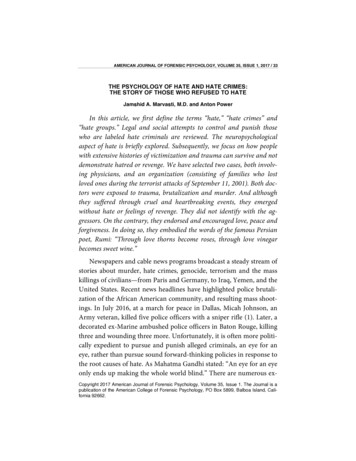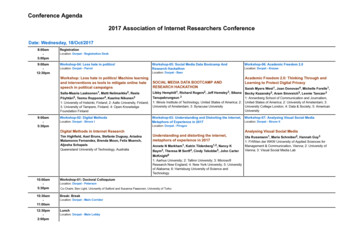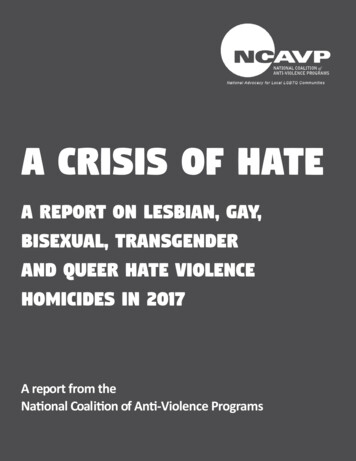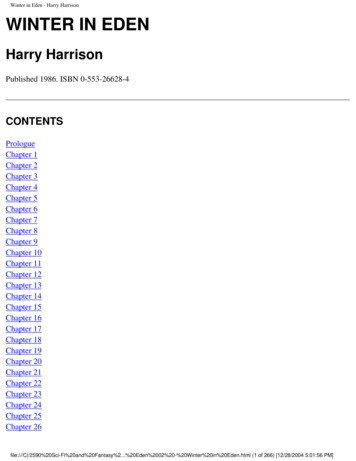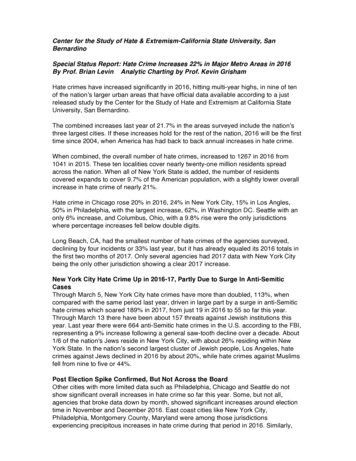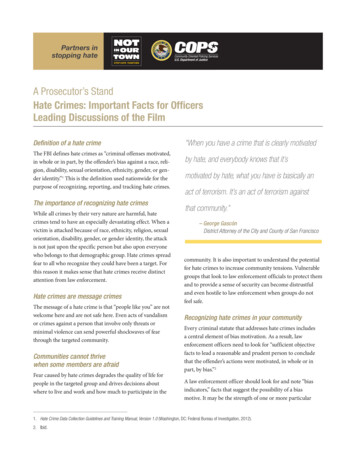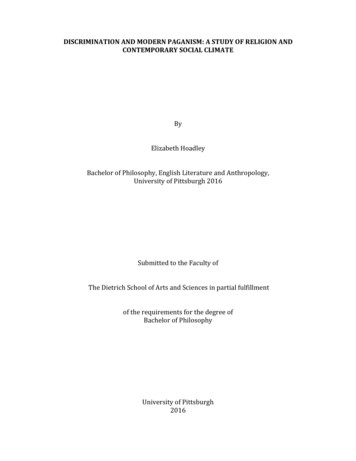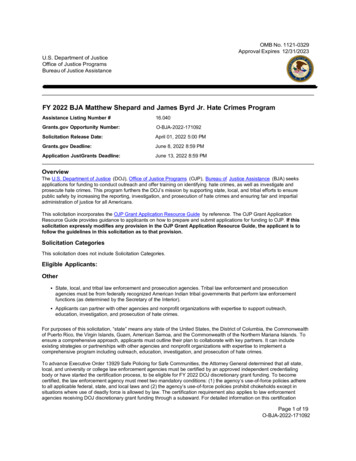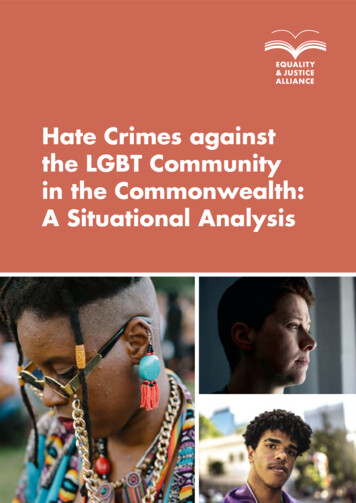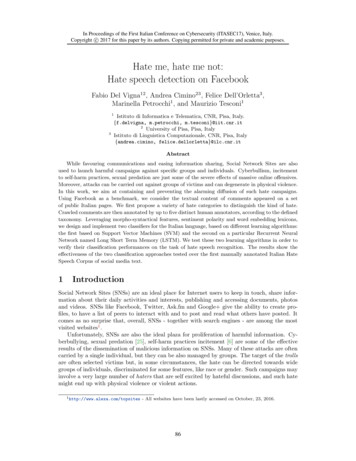
Transcription
In Proceedings of the First Italian Conference on Cybersecurity (ITASEC17), Venice, Italy.Copyright c 2017 for this paper by its authors. Copying permitted for private and academic purposes.Hate me, hate me not:Hate speech detection on FacebookFabio Del Vigna12 , Andrea Cimino23 , Felice Dell’Orletta3 ,Marinella Petrocchi1 , and Maurizio Tesconi113Istituto di Informatica e Telematica, CNR, Pisa, Italy.{f.delvigna, m.petrocchi, m.tesconi}@iit.cnr.it2University of Pisa, Pisa, ItalyIstituto di Linguistica Computazionale, CNR, Pisa, Italy{andrea.cimino, felice.dellorletta}@ilc.cnr.itAbstractWhile favouring communications and easing information sharing, Social Network Sites are alsoused to launch harmful campaigns against specific groups and individuals. Cyberbullism, incitementto self-harm practices, sexual predation are just some of the severe effects of massive online offensives.Moreover, attacks can be carried out against groups of victims and can degenerate in physical violence.In this work, we aim at containing and preventing the alarming diffusion of such hate campaigns.Using Facebook as a benchmark, we consider the textual content of comments appeared on a setof public Italian pages. We first propose a variety of hate categories to distinguish the kind of hate.Crawled comments are then annotated by up to five distinct human annotators, according to the definedtaxonomy. Leveraging morpho-syntactical features, sentiment polarity and word embedding lexicons,we design and implement two classifiers for the Italian language, based on different learning algorithms:the first based on Support Vector Machines (SVM) and the second on a particular Recurrent NeuralNetwork named Long Short Term Memory (LSTM). We test these two learning algorithms in order toverify their classification performances on the task of hate speech recognition. The results show theeffectiveness of the two classification approaches tested over the first manually annotated Italian HateSpeech Corpus of social media text.1IntroductionSocial Network Sites (SNSs) are an ideal place for Internet users to keep in touch, share information about their daily activities and interests, publishing and accessing documents, photosand videos. SNSs like Facebook, Twitter, Ask.fm and Google give the ability to create profiles, to have a list of peers to interact with and to post and read what others have posted. Itcomes as no surprise that, overall, SNSs - together with search engines - are among the mostvisited websites1 .Unfortunately, SNSs are also the ideal plaza for proliferation of harmful information. Cyberbullying, sexual predation [25], self-harm practices incitement [6] are some of the effectiveresults of the dissemination of malicious information on SNSs. Many of these attacks are oftencarried by a single individual, but they can be also managed by groups. The target of the trollsare often selected victims but, in some circumstances, the hate can be directed towards widegroups of individuals, discriminated for some features, like race or gender. Such campaigns mayinvolve a very large number of haters that are self excited by hateful discussions, and such hatemight end up with physical violence or violent actions.1 http://www.alexa.com/topsites- All websites have been lastly accessed on October, 23, 2016.86
Work in [21] characterises the attacker and it provides a definition of trolls, i.e., online userspretending to sincerely strive for be part of an online community, but whose real intentions areto cause disruption and exacerbate conflict, for the purposes of their own amusement. Thus,sexists, religious fanatics, political extremists massively use SNSs to foster hate against specificindividuals/organizations, by causing a sounding board effect, which may critically damage thetargets of the hate campaign, by using both psychological and physical violence. Althoughmore experienced users could be able to face threats and trolls, the great majority of themcannot easily bear the attacks, especially minors and those who might get exposed mediaticallyto public judgment. Media frequently report evidences about the (unfortunately extreme insome cases) consequences that naı̈ve and emotive users have faced to2 .This work aims at containing and preventing the alarming diffusion of massive online hatecampaigns on SNSs and it focuses on Italian texts. The issue has been tackled in the pastwith different approaches, laying somehow in the middle between pre-emption and mending.One approach aims at mitigating chat conversations through ad hoc filters, like in [38], bysemantically detecting offensive content and removing it. The second approach operates onpublished content and tries to remove the offending one, often leveraging the analysis on multiplemessages, as in [3, 7, 36].Contributions. Our aim is not censoring online content, as we mostly address its classification for the Italian language to pinpoint anomalous waves of hate and disgust. Using Facebookas a benchmark, we classify the content of comments appeared on a set of public pages. Wecontribute along the following dimensions: we design and develop the first hate speech classifier for the Italian language and we compare two different approaches based on state-of-the-art learning algorithms for sentimentanalysis tasks; starting from classifying the single comment on a Facebook page, the results proposed inthis paper constitute the prelude to the detection of violent discussions as a whole. Thiswith the ultimate goal to promptly detect waves of hate, which several users may takepart to, as it happened recently and unfortunately on Facebook pages3,4 ; we introduce a taxonomy of a variety of hate categories, expanding the classes proposedin [19] and specifically considering the subject of the hate, like, e.g., hate for religious,racial, socio-economical reasons; while not directly employed here in the classification, thedefinition of such taxonomy is a step towards more refined classification tasks.Next section introduces the corpus for hate speech detection. Section 3 presents our classification techniques and reports its performance results. In Section 4, we discuss related workon detecting textual aggressions on social media. Finally, Section 5 concludes the paper.2Hate Speech CorpusThis section reports on the retrieval and annotation phase of our hate speech Italian corpus.2 blica.it/ (La Repubblica - Italian newspaperonline edition)3 07/ (Facebook page)4 https://goo.gl/jYJPoZ (Il Tempo - Italian Newspaper online edition)87
2.1Data crawlingAiming at monitoring the “hate level” across Facebook, we have built a corpus of commentsretrieved from the Facebook public pages of Italian newspapers, politicians, artists, and groups.These pages typically host discussions spanning across a variety of topics.We have developed a versatile Facebook crawler, which exploits the Graph API5 to retrievethe content of the comments to Facebook posts. The crawler leverages the flexibility of theLaravel framework to deploy a wide set of features, like flexibility, code reuse, different storagestrategies and parallel processing. Implemented as a Web service, it can be controlled through aWeb interface or using a cURL command6 . The tool requires a set of registered application keysand some target pages to crawl. It is capable of storing data in the filesystem either as JSON7files, or in Kafka8 queues or in Elasticsearch9 indexes. According to the number of applicationkeys provided to the application, it is able to crawl multiple pages in parallel. Starting from themost recent post, the crawler collects all the information related to the posts, up to commentsto comments. For the sake of simplicity, in this work we have however limited our analysis todirect comments to the posts.2.2Data annotationThe crawler was used to collect comments related to a series of web pages and groups, chosensince we suspected to possibly contain hate content.Title of Facebook idianoemosocazzinoiconsalviniufficialeAnnotated notations15298584125346023413575270Table 1: Dataset description and annotationsOverall, we collected 17,567 Facebook comments from 99 posts crawled from the selectedpages: 6,502 of them have been annotated at least once (spanning over 66 posts) and at mostreceived 5 annotations from distinct human annotators. We asked to 5 bachelor students toannotate comments, and the majority of comments received more than one annotation. Students annotated 5742, 3870, 4587, 2104 and 2006 comments respectively. In particular, amongthe annotated comments, 3,685 received at least 3 annotations. On average, each annotatorannotated about 3,662 comments.The annotators were asked to assign one class to each post, where classes span over thefollowings levels of hate: No hate, Weak hate, and Strong hate.We then divided hate messages into distinct categories: Religion, Physical and/or mentalhandicap, Socio-economical status, Politics, Race, Sex and Gender issues, and Other.5 https://developers.facebook.com/docs/graph-api6 https://curl.haxx.se7 http://json.org8 http://kafka.apache.org9 https://www.elastic.co/products/elasticsearch88
Given that the majority of comments has been annotated by more than one annotator, wehave also computed the Fleiss’ kappa κ inter-annotator agreement metric [20], which measuresthe level of agreement of different annotators on a task. The level of agreement among annotators conveys the level of the difficulty of a task. In our case, considering the 1,687 commentsthat received annotations from all the 5 annotators, we obtain κ 0.19 when discriminatingover three hate classes, while κ 0.26 over two classes (where Strong Hate and Weak Hate havebeen merged together). Such low κ values testify that the annotation task was really hard forour students.3Text ClassificationThis section describes the classification approaches and gives their results. On the annotateddataset, we compute a series of features, described in detail in the following. A series of lexiconsused to derive part of the features is described in Section 3.1.1. Comments in our dataset arethen represented as a vector of features, given as input to the classifier, along with the resultof the annotation. In the training phase, the classifier learns to classify a comment accordingto the values of its features and the annotation result. In the test phase, the classifier takesdecision and tags comments as expressing hatred or not, according to the learned model.3.1The classifierWe tested two different classifiers based on different learning algorithms: the first one based onSupport Vector Machines (SVM) and the second one on a particular Recurrent Neural Networknamed Long Short Term Memory (LSTM). While SVM is an extremely strong performer, hardlyto be transcended, unfortunately these types of algorithms capture “sparse” and “discrete” features in document classification tasks. This makes the detection of relations in sentences reallyhard, while this is often the key factor in detecting the overall sentiment polarity of a document [33]. On the contrary, LSTM networks are a specialization of Recurrent Neural Networks(RNN), which are able to capture long-term dependencies in a sentence. This type of neuralnetwork has been recently tested on sentiment analysis tasks [33, 37], reaching outperformingclassification performance [29], with even a 3-4 points improvement with respect to commonlyused learning algorithms. In this work, we use the Keras [8] deep learning framework andLIBSVM [5] to generate, respectively, the LSTM and the SVM statistical models. Since ourapproach relies on morpho-syntactically tagged texts, the hate speech corpus was automaticallymorpho-syntactically tagged by the Part-Of-Speech tagger described in [14].3.1.1Lexical resourcesTo improve the overall accuracy of our system, we used both sentiment polarity and wordembedding lexicons. Sentiment polarity lexicons10 were already successfully tested for the classification of positive, negative and neutral sentiment of Italian social media posts [2]. Weused the ones described in [9] which include a manually created lexicon for Italian [35], twoautomatically translated sentiment polarity lexicons originally created for English [23, 35], anautomatically created Twitter sentiment polarity lexicon and two word similarity lexicons automatically created using word2vec11 [28], starting from two Italian corpora: (i) PAISÀ [26], a10 Wedownloaded the lexicons from www.italianlp.it11 http://code.google.com/p/word2vec/89
large corpus of authentic contemporary Italian texts; and (ii) a lemmatized corpus of 1,200,000tweets, automatically collected.In addition to these resources, we created two Word Embedding lexicons, to overcome theissue that lexical information in a short text can be very sparse. For this purpose, we trainedtwo predict models using word2vec. These models learn lower-dimensional word embeddings.Embeddings are represented by a set of latent (hidden) variables and each word is a multidimensional vector that represent a specific instantiation of these variables. The first lexicon was builtusing a tokenized version of the itWaC corpus12 . The itWaC corpus is a 2 billion word corpusconstructed from the Web, limiting the crawl to the .it domain and using medium-frequencywords from La Repubblica corpus and basic Italian vocabulary lists as seeds. The second lexiconwas built from a tokenized corpus of tweets. This corpus was collected using the Twitter APIsand it is made up of 10,700,781 Italian tweets.3.1.2The SVM classifierThe SVM classifier exploits a wide set of features, ranging across different levels of linguisticdescription. With the exception of the word embedding combination, these features have beenalready used in sentiment polarity classification tasks [9] showing their effectiveness. The features are organised into three main categories: raw and lexical text features, morpho-syntacticand syntactic features, and lexicon features.Raw and Lexical Text Features. Number of tokens: number of tokens occurring in theanalyzed text; Character n-grams: presence or absence of contiguous sequences of charactersin the analyzed text. Word n-grams: presence or absence of contiguous sequences of tokensin the analyzed text. Lemma n-grams: presence or absence of contiguous sequences of lemmaoccurring in the analyzed text. Repetition of n-grams chars: presence or absence of contiguousrepetition of characters in the analyzed text. Punctuation: checks whether the analyzed textfinishes with one of the following punctuation characters: “?”, “!”.Morpho-syntactic and Syntactic Features. Coarse grained Part-Of-Speech n-grams:presence or absence of contiguous sequences of coarsegrained PoS, corresponding to the maingrammatical categories (noun, verb, adjective). Coarse grained Part-Of-Speech distribution: thedistribution of nouns, adjectives, adverbs, numbers in the text. Fine grained Part-Of-Speechn-grams: presence or absence of contiguous sequences of fine-grained PoS, which representssubdivisions of the coarse-grained tags (e.g., the class of nouns is subdividefalice d into propervs common nouns, verbs into main verbs, gerund forms, past particles). Dependency typesn-grams: presence or absence of sequences of dependency types in the analyzed text. Thedependencies are calculated with respect to i) the hierarchical parse tree structure and ii) thesurface linear ordering of words Lexical Dependency n-grams: presence or absence of sequencesof lemmas calculated with respect to the hierarchical parse tree. Lexical Dependency Tripletn-grams: distribution of lexical dependency triplets, where a triplet represents a dependencyrelation as (ld, lh, t), where ld is the lemma of the dependent, lh is the lemma of the syntactichead and t is the relation type linking the two. Coarse Grained Part-Of-Speech Dependencyn-grams: presence or absence of sequences of coarse-grained Part-of-Speech, calculated withrespect to the hierarchical parse tree. Coarse Grained Part-Of-Speech Dependency Triplet ngrams: distribution of coarse-grained Part-of-Speech dependency triplets, where a triplet represents a dependency relation as (cd, ch, t), where cd is the coarse-grained Part-of-Speech of the12 http://wacky.sslmit.unibo.it/doku.php?id corpora90
dependent, h is the coarse-grained Part-of-Speech of the syntactic head and t is the relationtype linking the two.Lexicon features. Lemma sentiment polarity n-grams: for each n-gram of lemmas extractedfrom the analyzed text, the feature checks the polarity of each component lemma in the existingsentiment polarity lexicons. Lemmas that are not present are marked with the ABSENT tag.This is for example the case of the trigram “tutto molto bello” (all very nice) that is markedas “ABSENT -POS -POS ” because molto and bello are marked as positive in the consideredpolarity lexicon and tutto is absent. The feature is computed for each existing sentiment polaritylexicons. Emoticons: presence or absence of positive or negative emoticons in the analyzed text.The lexicon of emoticons was extracted from http://it.wikipedia.org/wiki/Emoticon andmanually classified. Polarity modifier: for each lemma in the text occurring in the sentimentpolarity lexicons, the feature checks the presence of adjectives or adverbs in a left contextwindow of size two. If this is the case, the polarity of the lemma is assigned to the modifier. Thisis for example the case of the bigram “non interessante” (not interesting), where “interessante”is a positive word, and “non” is an adverb. Accordingly, the feature “non POS” is created. Thefeature is computed 3 times, checking all the existing sentiment polarity lexicons. PMI score: foreach set of unigrams, bigrams, trigrams, four-gramsP and five-grams that occur in the analyzedtext, the feature computes the score given by i–gram text score(i–gram) and it returns theminimum and the maximum values of the five values (approximated to the nearest integer).Distribution of sentiment polarity: this feature computes the percentage of positive, negativeand neutral lemmas that occur in the text. To overcome the sparsity problem, the percentagesare rounded to the nearest multiple of 5. The feature is computed for each existing lexicon.Most frequent sentiment polarity: the feature returns the most frequent sentiment polarity ofthe lemmas in the analyzed text. The feature is computed for each existing lexicon. Sentimentpolarity in text sections: the feature first splits the text in three equal sections. For each section,the most frequent polarity is computed using the available sentiment polarity lexicons. Thepurpose of this feature is identifying changes of polarity within the same text. Word embeddingscombination: the feature returns the vectors obtained by computing separately the average ofthe word embeddings of the nouns, adjectives and verbs of the text. It has been computed oncefor each word embedding lexicon.3.1.3The LSTM classifierThe LSTM unit was initially proposed by Hochreiter and Schmidhuber [22]. LSTM units areable to propagate an important feature that came early in the input sequence over a longdistance, thus capturing potential long-distance dependencies. LSTM is a state-of-the-art performer for semantic composition and it allows to compute the representation of a documentfrom the representation of its words, with multiple abstraction levels. Each word is representedby a low dimensional, continuous and real-valued vector.We employed a bidirectional LSTM architecture since it allows to capture long-range dependencies from both the directions of a document by constructing bidirectional links in thenetwork [31]. In addition, we applied a dropout factor to both the input gates and to the recurrent connections in order to prevent overfitting which is a typical issue of neural networks [17].As suggested in [17], we have chosen a dropout factor value in the optimum range [0.3, 0.5], morespecifically 0.45 for this work. Concerning the optimization process, categorical cross-entropyis used as a loss function and optimization was performed by the rmsprop optimizer [34].To train the LSTM architecture, each input word in the text is represented by a 262dimensional vector which is composed by:91
Word embeddings: the concatenation of the two word embeddings extracted by the two availableWord Embedding lexicons (128 components for each word embedding, thus resulting in a totalof 256 components), and for each word embedding an extra component was added in orderto handle the ”unknown word”. Word polarity: the corresponding word polarity obtainedby exploiting the Sentiment Polarity lexicons. This feature adds 3 extra components in theresulting vector, one for each possible outcome in the lexicons (negative, neutral, positive). Weassumed that a word not found in the lexicons has a neutral polarity. End of Sentence: acomponent indicating whether or not the sentence was totally read.3.2Experiments and ResultsWe conducted two different classification experiments: the first considering the three differentcategory of hate (Strong hate, Weak hate and No hate) the second considering only two categories, No hate and Hate, where the last category was obtained by merging the Strong hate andWeak hate classes.For the experiments, we used only documents that were annotated at least by three differentannotators and where the most annotated class exists. This process resulted in two datasets:the three-class dataset, composed by 3,356 documents - divided into 2,816 No hate, 410 Weakhate and 130 Strong hate documents, and the two-class dataset, composed by 3,575 documents- divided into 2,789 No hate and 786 Hate. To balance the datasets, we selected a subset of theNo hate texts, which was limited to the double size of the documents belonging to the Weakhate class in the three-class experiment and to the double size of the Hate class in the two-classone. To evaluate the accuracy of the two hate speech classifiers in the two experiments, wefollowed a 10-fold cross validation process: each dataset was randomly split in ten different nonoverlapping training and test sets. The overall Accuracy, Precision, Recall and F-score for eachclass were calculated as the average of the these values over all the ten test sets. Accuracy,Precision, Recall and F-score are evaluation metrics employed in standard classification tasks.In our scenario: Accuracy measures how many comments are correctly identified in the classes;Precision measures how many comments, among those classified as expressing hate, have beencorrectly identified; Recall expresses how many comments, in the whole set, have been correctlyrecognized: a low recall means that many relevant comments are left unidentified and F-scoreis the armonic mean of Precision and Recall.Table 2 reports the results for the three-class experiment. Both SVM and LSTM are notable to discriminate between the three classes and this is particularly true for the Strong hateone. These results may be due to the small number of Strong hate documents (that is the classwith the lowest number of documents) and the low level of annotator agreement. These resultslead us to conduct the two-class experiment, whose accuracies are in Table 3. As we expected,the results are much more higher than those in the previous experiment. This is probably dueto the higher number of Hate documents with respect to the Strong e Weak classes and to thehigher annotator agreement with respect to the three-class experiments.To evaluate the impact of the annotator agreement in the classification performances, weperformed a last experiment, where we selected the documents for which at least 70% of theannotators were in agreement (321 Hate and 642 No-Hate documents). As Table 3 shows,the more agreement yields an increasing accuracy for both the classification algorithms. Thisimprovement is particularly significant for the classification of the Hate class, with F-score ofabout 72%. These results pave the way to the employment of our system in a real-use context.In addition, the outcome shows that this Hate Speech corpus, filtered with respect to theannotator agreement, allows to build automatic hate speech classifiers able to achieve accuracy92
in line with the ones obtained in mostly investigated sentiment analysis tasks for Italian, suchas subjectivity and polarity classification [2].ClassifierSVMLSTMAccuracy (%)64.6160.50Strong hatePrec. Rec. F-score.452.189.256.501.054.097Prec.523.434Weak hateRec. F-score.525.519.159.221Prec.724.618No hateRec. F-score.794.757.950.747Table 2: Ten-fold cross validation results on Strong hate, Weak hate and No hate classes.ClassifierSVMLSTMSVMLSTMAccuracy 8.594.640.6832.657 70% of 859No hateRec. F-score.817.797.791.805.872.822.851.838Table 3: Ten-fold cross validation results on Hate and No hate classes.4Related WorkHere, we briefly revise academic work on trolls and hate speech detection. Interestingly, theconnections between the users profiles on SNSs are often strictly related to the connections intheir real life [16]. Using machine learning, it was possible to recognize those users that adopttroll profiles in cyberbullying practices [4, 13, 18]. Similarly, text analysis approaches have beenused to link together the contents of anonymous users among different opinion websites [1].Relationships based on profile connections and behaviors have been exploited to effectivelyidentify fake Facebook profiles [10], while lightweight profile features succeeded in recognisingfake Twitter followers [11, 12]. Regarding text classification for automatic hate speech detection,a seminal work is in [32]. In [27], the authors propose a rule-based classifier to distinguishbetween legitimate and abusive information in texts. PALADIN [24] is a pattern mining tool tomine patterns of language, to detect anti-social behaviors of users. The authors of [36] focus onTwitter and propose a semi-supervised approach and statistical topic modeling for the detectionof offensive content, while work in [3] presents a supervised machine learning text classifier,trained and tested to distinguish between hateful and antagonistic responses, with a focus onrace, ethnicity and religion. Work in [15] adopts neural language models to learn distributedlow-dimensional representations of comments. The approach generates text embeddings thatcan be used to feed a classifier. The authors of in [19] describe the distinction among flameand hate speech (the latter being more directed to groups, rather than individuals). The samework proposes the three level hate classification adopted in this paper (partially suffering forthe low IAA too). Some studies concentrate on the users’ behaviour. Authors of [30] proposea reputation system, which tracks reputation of users using positive and negative opinions. Abehavioral analysis of banned users is in [7], showing a certain degree of similarity in their texts,containing often irrelevant content too.93
5ConclusionsThis paper introduced the first hate speech classifier for Italian texts. Considering a binaryclassification, the classifier achieved results comparable with those obtained in mostly investigated sentiment analysis tasks for Italian. Encouraged by such promising outcome, we leavefor future work the refinement of the classifier results when considering distinction (i) amonghate levels (whereas the current classifier fails to achieve satisfactory results) and (ii) amongdifferent types of hate (which we defined in the paper and worked with at the annotation level).We will carry out a thorough analysis of the results of the two classifiers to investigate whetherthey can be combined in order to increase the performance. In addition, we are enlarging theannotation process, both to increase the corpus size and to collect more annotations for a singlecomment. We are testing new annotation methods, evaluating the inter-annotator agreementfor validating the annotation on the different degrees of hate. Besides, we will investigate theeffect of sarcasm on the classifier performance. From the classification of single comments, thehate classifier may evolve to detect bursts of hate, thus preventing that virtual discussions giverise to severe injures to people and assets. Given that human moderators cannot monitor thehuge user generated texts on social networks, we believe this work represents the basis to trackdivergent states of Italian texts in online conversations.Acknowledgements. The authors would like to thank Salvatore Bellomo and Serena Tardelli fortheir actionable support.References[1] Mishari Almishari and Gene Tsudik. Exploring linkability of user reviews. In ESORICS, pages307–324. Springer Berlin Heidelberg, 2012.[2] Valerio Basile, Andrea Bolioli, Malvina Nissim, Viviana Patti, and Paolo Rosso. Overview of theEvalita 2014 sentiment polarity classification task. In EVALITA, 2014.[3] Peter Burnap and Matthew Leighton Williams. Hate speech, machine classification and statisticalmodelling of information flows on Twitter. In Internet, Policy and Politics, 2014.[4] Erik Cambria et al. Do not feel the trolls. In Semantic Web, 2010.[5] Chih-Chung Chang and Chih-Jen Lin. LIBSVM: A library for support vector machines. ACMTransactions on Intelligent Systems and Technology, 2:27:1–27:27, 2011.[6] S. Chattopadhyay et al. Suicidal risk evaluation using a similarity-based classifier. In AdvancedData Mining and Applications, pages 51–61. Springer Berlin Heidelberg, 2008.[7] Justin Cheng, Cristian Danescu-Niculescu-Mizil, and Jure Leskovec. Antiso
We have developed a versatile Facebook crawler, which exploits the Graph API 5 to retrieve the content of the comments to Facebook posts. The crawler leverages the exibility of the Laravel framework to deploy a wide set of features, like exibility, code reuse, di erent storage strategies and parallel processing.
